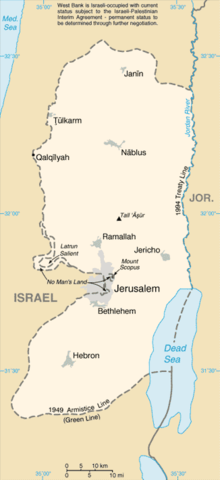
The Israeli permit regime in the West Bank is the legal regime that requires Palestinians to obtain a number of separate permits from the Israeli military authorities governing Palestinians in the Israeli-occupied West Bank for a wide range of activities.[1][2][a] The first military order requiring permits for the Palestinians was issued before the end of the 1967 Six-Day War. The two uprisings of 1987 and 2001 were met by increased security measures, differentiation of IDs into green and red, policies of village closures, curfews and more stringent restrictions on Palestinian movement, with the general exit permit of 1972 replaced by individual permits. The stated Israeli justification for this new permit regime regarding movements was to contain the expansion of the uprisings and protect both the IDF and Israeli civilians from military confrontations with armed Palestinians.[3] The regime has since expanded to 101 different types of permits covering nearly every aspect of Palestinian life,[4][5] governing movement in Israel and in Israeli settlements, transit between Gaza and the West Bank, movement in Jerusalem and the seam zone, and travel abroad via international borders.[6] The Israeli High Court has rejected petitions against the permit regime, allowing that it severely impinges on the rights of Palestinian residents but that the harm was proportionate.[7]
Considered an example of racial profiling by scholars like Ronit Lentin, Yael Berda and others,[8][9][10] the regime has been characterized as arbitrary and as one that turned such rights as freedom of movement into mere privileges that could be granted or revoked by the military authority.[11] The regime itself has been likened to the South African pass laws under apartheid,[b][12][13][14][15] with Jennifer Loewenstein writing that the regime is "more complex and ruthlessly enforced than the pass system of the apartheid regime."[16] Israel has defended the permit regime as necessary to protect Israelis in the West Bank against what it describes as continued threats of attacks by Palestinian militants.[17]
- ^ Berda 2017a.
- ^ Gross 2017, p. 324.
- ^ Al-Qadi 2018, pp. 3–4.
- ^ Levinson 2011.
- ^ Gordon 2008a, p. 34.
- ^ Al-Qadi 2018, p. 7.
- ^ Cahana & Kanonich 2013, p. 7.
- ^ Peteet 2017, p. 9.
- ^ Abowd 2014, pp. 29, 191, 204–205.
- ^ Lentin 2018, p. 39.
- ^ Gordon 2008a, p. 25.
- ^ Clarno 2017, p. 4.
- ^ Ben-Naftali, Sfard & Viterbo 2018, p. 335—336.
- ^ Essed et al. 2018, p. 255.
- ^ Peteet 2017, p. 89.
- ^ Loewenstein 2006, p. 25.
- ^ Laub & Daraghmeh 2018.
Cite error: There are <ref group=lower-alpha> tags or {{efn}} templates on this page, but the references will not show without a {{reflist|group=lower-alpha}} template or {{notelist}} template (see the help page).